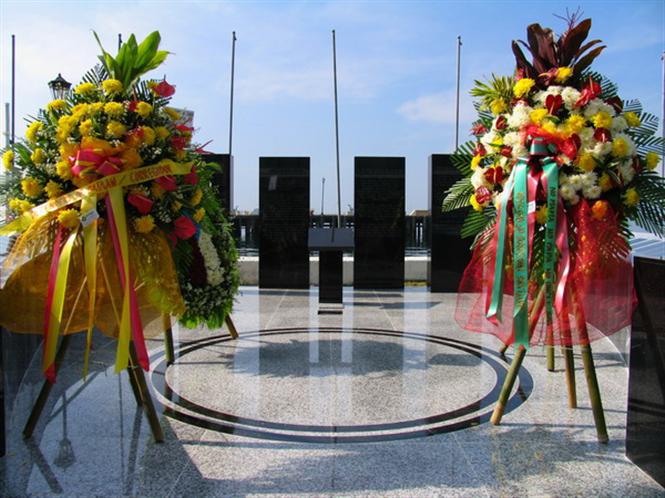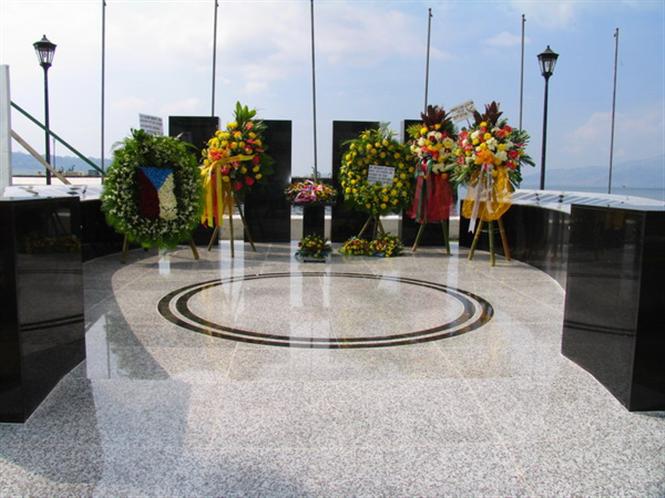Hellships Memorial
Description
The memorial is constructed of black Italian granite and consists of four large inscribed monoliths. The memorial commemorates all those who suffered and died on hellships across all of Asia. The inscription on the memorial says 'these heroes came from different homelands, different backgrounds, and different circumstances – but all were courageous and patriotic men whose lives were drastically altered and, in many cases, ended during their terrible journeys on the Hellships.
The Hellships Memorial will forever speak of this hope, serving as an anchor holding fast against the slow currents of complacency and forgotten loss'.
History
As early as the spring of 1942, only a few months after the fall of the Allied territories in the Far East, the Japanese began moving POWs by sea out of all the areas they had conquered - Singapore, Hong Kong, the Philippines, Java and other places and sending them to Japan, Taiwan, Burma, the Dutch East Indies and other areas to be used as slave labour. POWs were crammed with little or no water or food into stinking holds, filthy with coal dust, congealed sugar syrup or horse manure left over from previous voyages. Thousands of prisoners were transported on dozens of Japanese 'Hell Ships', and many thousands of those perished from murder, starvation, sickness and neglect - or were killed when the unmarked ships were attacked unknowingly by friendly forces. The Montevideo Maru was one such ship and, following its sinking, is the only one that sustained total loss of life of those held captive onboard.
The Hellships Memorial is a permanent tribute to all those allied prisoners of war and civilian internees from all nations who died, and the few who survived, the atrocity of the hellships.
Construction Information
Gerald Anderson, is a retired US Navy officer who became interested in the hellships while stationed at the US Naval Station, Subic Bay, working in an office located less than 500 meters from the resting place of one the most notorious hellships, the Oryku Maru. After retirement, Mr Anderson returned to the Philippines and began a fund raising program to build a fitting memorial to the POWs who suffered so much as prisoners of the Japanese.
Ostensibly an American initiative, Gerald Anderson met with Leslie Ann Murray of the Filipine-American Memorial Endowment (FAME), a subcommittee of the American Chamber of Commerce in the Philippines, and formed a relationship with them. FAME is best known for placing and maintaining the kilometre markers along the Bataan Death March, and Corregidor and other sites important to the American POW story.
On 22 January 2006, after two years of hard work, the monument was dedicated by SBMA Chairman Feliciano Salonga with a key note speech by Duane Heisinger, whose father had been a POW on one of the Hellships.
Robert Chester, retired U.S. Navy Chief Boatswains Mate living in the Subic Bay area, began working on the Memorial project in 2005 and re-designed the original Hellships Memorial to its final construction form. Robert helped coordinate the construction of the memorial with the architect and construction firm, then took on the layout and construction of the Hellships Memorial Display inside the nearby Subic Bay Historical Center. The Hellships Museum Display was completed and dedicated 22 January 2006 in conjunction with the Hellships Memorial Dedication. Robert continues to be involved, planning and executing construction of the upgrades of the museum.
Location
Subic, Philippines.
The Hellships Memorial is located on the Subic Bay Freeport (SBF), which forms part of Luzon Sea on the west coast of the island of Luzon in Zambales, Philippines, about 100 kilometers northwest of Manila Bay. The memorial is located on the shoreline near the headquarters of the SBF, Bldg 229.
The sunken remains of the Oryoku Maru lie about 500 yards from the site.

